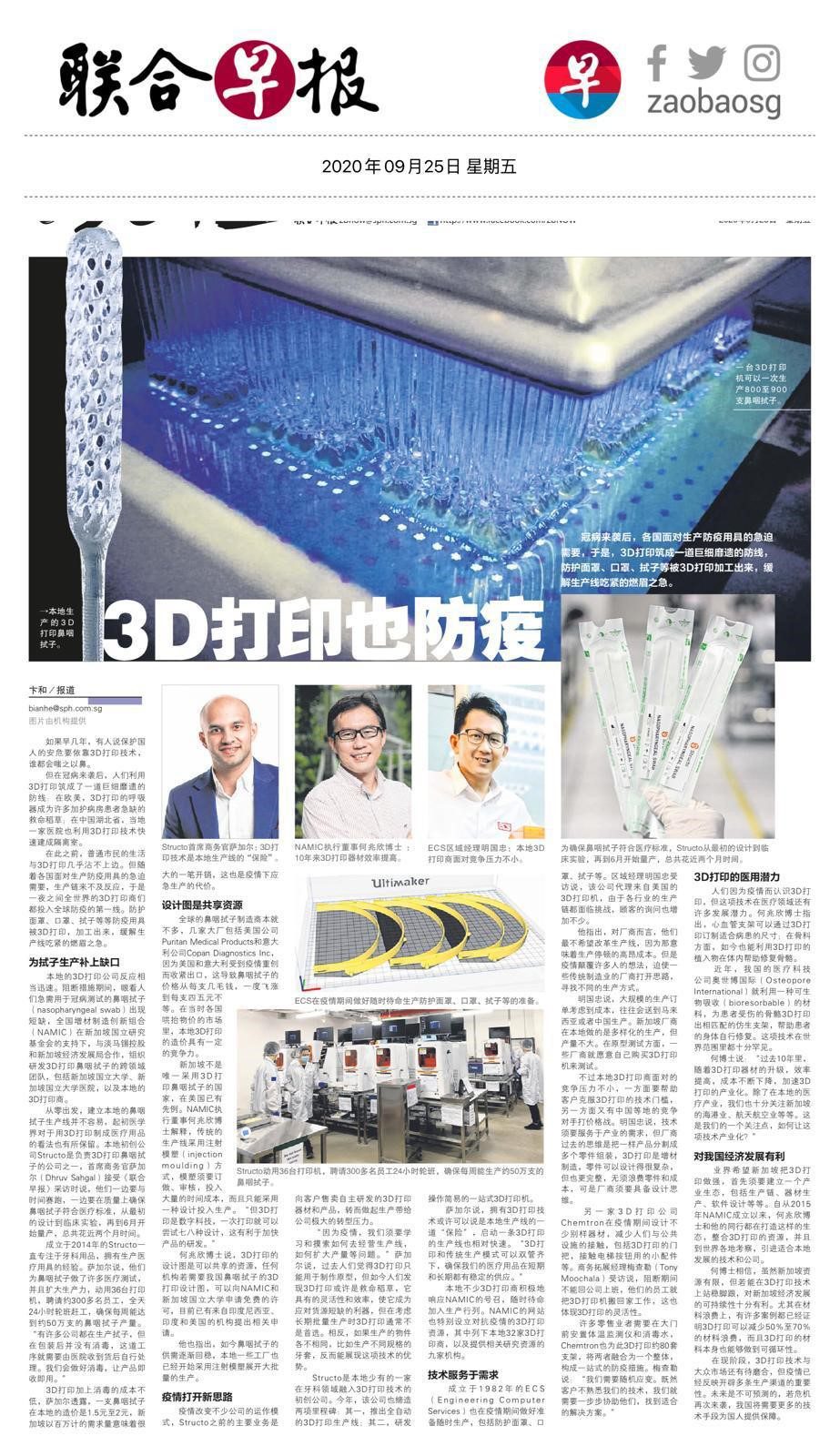
许多国家和生产线在疫情时,遇到了瓶颈;列如无法应付突然来临的高需求和要如何在短期内改善冗长乏味的制造过程。
而在全球在面临急需冠病测试的鼻咽拭子和短缺,新加坡也在在阻断措施期间竞速地探索如何在本地加速生鼻咽拭子。
全国增材制造创新组织在新加坡国立研究基金会的支持下,与淡马锡控股和新加坡经济发展局合作,组织研发3D打印鼻咽拭子的跨领域团队,包括新加坡国立大学,新加坡国立大学医院,以及本地的3D打印商。
Click here to read the article.
(联合早报 | 卞和提笔)从零出发,建立本地的鼻咽拭子生产线并不容易,起初医学界对于用3D打印制成医疗用品的看法也有所保留。本地初创公司Structo是负责3D打印鼻咽拭子的公司之一,首席商务官萨加尔(Dhruv Sahgal)接受《联合早报》采访时说,他们一边要与时间赛跑,一边要在质量上确保鼻咽拭子符合医疗标准,从最初的设计到临床实验,再到6月开始量产,总共花近两个月时间。
设计图是共享资源
全球的鼻咽拭子制造商本就不多,几家大厂包括美国公司Puritan Medical Products和意大利公司Copan Diagnostics Inc,因为美国和意大利受到疫情重创而收紧出口,这导致鼻咽拭子的价格从每支几毛钱,一度飞涨到每支四五元不等。在当时各国哄抬物价的市场里,本地3D打印的造价具有一定的竞争力。
新加坡不是唯一采用3D打印鼻咽拭子的国家,在美国已有先例。NAMIC执行董事何兆欣博士解释,传统的生产线采用注射模塑(injection moulding)方式,模塑须要订做、审核,投入大量的时间成本,而且只能采用一种设计投入生产。“但3D打印是数字科技,一次打印就可以尝试七八种设计,这有利于加快产品的研发。”
何兆欣博士说,3D打印的设计图是可以共享的资源,任何机构若需要我国鼻咽拭子的3D打印设计图,可以向NAMIC和新加坡国立大学申请免费的许可,目前已有来自印度尼西亚、印度和美国的机构提出相关申请。
他也指出,如今鼻咽拭子的供需逐渐回稳,本地一些工厂也已经开始采用注射模塑展开大批量的生产。
疫情打开新思路
疫情改变不少公司的运作模式,Structo之前的主要业务是向客户售卖自主研发的3D打印器材和产品,转而做起生产带给公司极大的转型压力。
“因为疫情,我们须要学习和摸索如何去经营生产线,如何扩大产量等问题。”萨加尔说,过去人们觉得3D打印只能用于制作原型,但如今人们发现3D打印或许是救命稻草,它具有的灵活性和效率,使它成为应对货源短缺的利器,但在考虑长期批量生产时3D打印通常不是首选。相反,如果生产的物件各不相同,比如生产不同规格的牙套,反而能展现这项技术的优势。
Structo是本地少有的一家在牙科领域融入3D打印技术的初创公司。今年,该公司也缔造两项里程碑:其一,推出全自动的3D打印生产线;其二,研发操作简易的一站式3D打印机。
萨加尔说,拥有3D打印技术或许可以说是本地生产线的一道“保险”,启动一条3D打印的生产线也相对快速。“3D打印和传统生产模式可以双管齐下,确保我们的医疗用品在短期和长期都有稳定的供应。”
本地不少3D打印商积极地响应NAMIC的号召,随时待命加入生产行列。NAMIC的网站也特别设立对抗疫情的3D打印资源,其中列下本地32家3D打印商,以及提供相关研究资源的九家机构。
对我国经济发展有利
业界希望新加坡把3D打印做强,首先须要建立一个产业生态,包括生产链、器材生产、软件设计等等。自从2015年NAMIC成立以来,何兆欣博士和他的同行都在打造这样的生态,整合3D打印的资源,并且到世界各地考察,引进适合本地发展的技术和公司。
何博士相信,虽然新加坡资源有限,但若能在3D打印技术上站稳脚跟,对新加坡经济发展的可持续性十分有利。尤其在材料浪费上,有许多案例都已经证明3D打印可以减少50%至70%的材料浪费,而且3D打印的材料本身也能够做到可循环性。
在现阶段,3D打印技术与大众市场还有待磨合,但疫情已经反映开辟多条生产渠道的重要性。未来是不可预测的,若危机再次来袭,我国将需要更多的技术手段为国人提供保障。
As countries faced a global shortage of the nasopharyngeal swabs during the pandemic, National Additive Manufacturing Innovation Cluster (NAMIC), with support from the National Research Foundation Singapore and in partnership with Temasek Holdings and the Economic Development Board, assembled a multi-disciplinary industry consortium to develop 3D printed nasal swabs.
Starting from scratch, it is not easy to establish a local nasopharyngeal swab production line. At first, the medical community had reservations about the use of 3D printing to produce medical supplies. Local startup, Structo is one of the companies responsible for 3D printing nasopharyngeal swabs. Chief Commercial Officer, Mr Dhruv Sahgal said in an interview with Lianhe Zaobao that they have to race against time while ensuring the quality of the nasopharyngeal swab meets the medical standards, and it took nearly two months from the initial design to clinical trials to mass production in June 2020.
Sharing Economy: Design Drawings of the Nasopharyngeal Swab
There are not many nasopharyngeal swab manufacturers in the world. Several major manufacturers, including the American company Puritan Medical Products and the Italian company Copan Diagnostics Inc, have tightened their exports due to the severe impact of the pandemic in the United States and Italy respectively, which has led to the skyrocketed price of nasopharyngeal swabs. From a few cents per piece, it once soared to near to 40-50 times during the peak of pandemic.
Singapore is not the only country that uses 3D-printed nasopharyngeal swabs. Dr. Ho Chaw Sing, Managing Director of NAMIC, explained that the traditional production line adopts injection moulding. The moulding needs to be customized and reviewed, which requires a lot of time and cost, and only one design can be used for production. “But 3D printing is a digital technology. You can try seven or eight designs in one print, which helps speed up product development.”
Dr Ho also shared that 3D printed design drawings are a shared resource. If any organization needs to adopt print-ready 3D printed design drawings of nasopharyngeal swabs, they can apply for a free license from NAMIC and the National University of Singapore.
He also pointed out that now the supply and demand of nasopharyngeal swabs are gradually stabilizing, and some local factories have begun to use injection molding to start mass production.
A Silver Lining: New Business Opportunities
The pandemic has disrupted the lives of many this year including businesses and the mode of operations however the toughest time will always shred one silver lining in the cloud coming out of the mayhem. Some of the businesses have changed its business model and Structo is one of them. Structo is one of the few local start-up companies that integrate 3D printing technology in the dental field. This year, the company also achieved two milestones: First, the launch of a fully automatic 3D printing production line; second, the development of a one-stop 3D printer with easy operation.
Many local 3D printers actively respond to NAMIC’s call and are ready to join the production ranks at any time. NAMIC also launched a COVID-19 Response Site to combat the pandemic where the site acts as a Directory to list down the 32 local 3D printers and nine institutions and their contact details that provide relevant research resources.
The Future of Manufacturing: Strengthen Singapore’s Economy
Dr. Ho believes that although Singapore’s resources are limited, if it can gain a foothold in 3D printing technology, it will be very beneficial to the sustainability of Singapore’s economic development. Especially in terms of material waste, many cases have proven that 3D printing can reduce material waste by 50% to 70%, and the 3D printed materials themselves can also be recyclable and building up a strong ecosystem is crucial.
At this stage, 3D printing technology and the mass market have yet to be adapted, but the epidemic has already reflected the importance of opening up multiple production channels. The future is unpredictable. If the crisis strikes again, our country will need more technical means to provide protection for the people.

